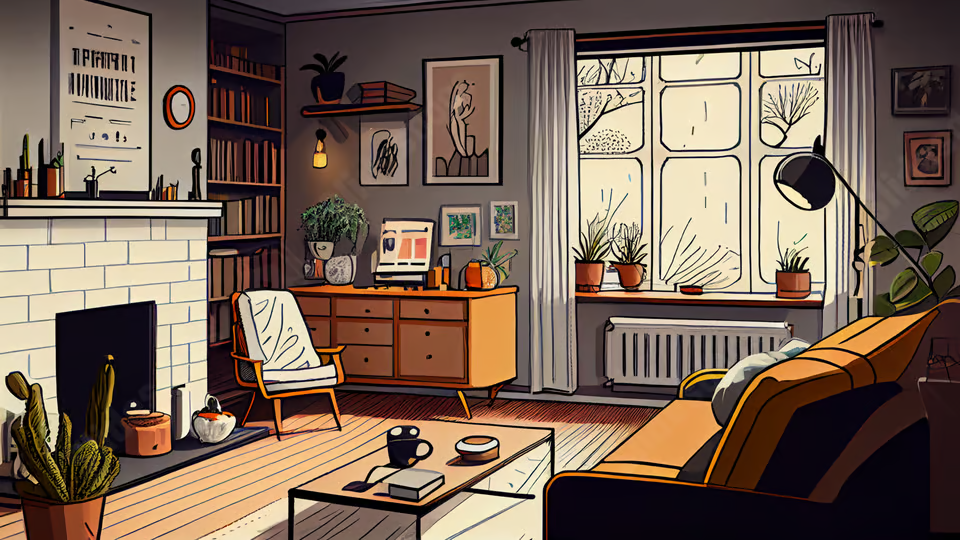Living in small spaces is common for many city residents and fans of tiny homes. As cities grow, making the most of every square foot is important. Small living spaces can be challenging. Limited storage, unclear areas for different activities, and constant clutter are some of the issues. But with the right design ideas, these can be managed.
With the rising population, there are fewer properties available, and many people are looking for them. Builders and real estate agents came up with a creative solution. These small spaces include studio apartments and sometimes one, two, or three-bedroom units. Contractors had to be creative with the design. They needed to provide enough storage and make the space feel comfortable.
Designing small spaces requires big thinking. A room doesn’t need to be large to look good. Many well-designed spaces are small. They use their size to their advantage by highlighting unique features. Ceiling murals, custom woodwork, and other special touches add visual interest.
In this article, we will share tips and tricks for designing small spaces. These ideas will help improve your home life.
Table of Contents
Tips
Here are some practical tips and tricks for designing your small space effectively:
Install Shelves in Unused Areas
Using blank spaces to build shelves is a smart way to add storage and style to a small space. Installing shelves around doorways can create a striking visual impact and make the room appear taller. These shelves maximize vertical space and provide storage without taking up floor area. You can use these shelves for books, decor, or everyday items. They keep the room organized and free up space for other furniture.
Enhance Your Space with Paint
Painting is an easy and effective way to transform a room. A fresh coat of paint can make a space feel more luxurious and inviting. You can choose a solid color for a clean look or go for a textured finish like Roman clay for added depth. Rich, saturated colors can make the walls and ceiling appear larger, enhancing the overall feel of the room. Using different colors to delineate spaces can help create distinct areas, such as an entryway, within an open floor plan. Painting is a versatile tool that can instantly upgrade the look and feel of your home.
Fresh paint, endless possibilities. Source: Synstudio.ca
Use Curtains to Make a Room Look Larger
Curtains can create the illusion of a larger room. Even if your windows are spaced apart, running a drapery track from wall to wall on the ceiling can help. This trick not only makes the wall seem bigger but also adds a soft touch to the space. Choose sheer materials for the curtains to allow light to flow through. This makes the room feel airy and open. Inside the window frame, mount a roller shade or blind for privacy and light control. This combination helps to maximize the visual impact without overwhelming the space.
Create Your Own Built-Ins
Built-ins can transform unused nooks and crannies into functional spaces. Many homes have areas hiding old ductwork or chimneys. These can be perfect spots for built-ins. You can install shelves for storage, create a cozy seating area, or combine both for a multifunctional space. Built-ins make these otherwise unusable spaces practical and help keep the rest of your home organized. Customizing these built-ins to match your home’s decor will make them blend easily and enhance the aesthetic.
Balance Your Art with Blank Walls
In a small apartment, you can use a gallery wall with various frame styles and artworks to add visual interest. However, leaving one wall completely blank can provide a much-needed visual break. This blank wall can make the room feel less cluttered and more open. It also serves a practical purpose, such as a backdrop for projecting movies. This balance between art and blank space ensures that your room feels spacious and harmonious. This makes it more comfortable and inviting.
Art shines brighter with space to breathe. Source: Kreafolk
Use Screens and Room Dividers
Room dividers are essential in small spaces. They create separate areas in a studio apartment. You can divide the living room from the bedroom or set up a private vanity space near a cupboard. They’re also great for creating distinct play areas for kids while you entertain guests in the dining area. Room dividers are versatile. They can be folded away for easy storage and provide privacy whenever needed.
Consider using slider screens instead of permanent walls. These foldable screens are innovative solutions for creating designated spaces. You can have a home office or guest room within the confines of a studio or one-bedroom apartment. They can also create the illusion of separate rooms based on your needs and preferences.
Utilize the Entryway
Make the most of your small home’s entryway. Incorporate Japanese design concepts like an express foyer or Genkan, a small indoor porch. If your apartment lacks a dedicated entryway, use area rugs to delineate living spaces or install floor mats near the doorway. A long carpet can guide guests towards the living or dining area, enhancing the flow of your home.
Install shoe racks in the entryway to save closet space and maintain cleanliness. Adding indoor plants can brighten up the space and bring a touch of color and positivity to your home environment. Indoor plants improve aesthetics and also contribute to a healthier living environment by purifying the air.
Add More Lighting
Enhancing lighting can significantly improve the feel of your home. If changing existing fixtures is difficult, consider adding extra lamps. Plug-in pendants or wall sconces can be used even without existing electrical outlets. Now we have modern cord covers and options that blend smoothly into the decor.
Replace builder-grade lights with decorative fixtures to elevate the room’s style. A statement light fixture can serve as the focal point and enhance the ambiance of the space.
To make small spaces feel larger, use light colors like whites, pastels, and soft neutrals. These shades reflect more light and give the room a more spacious feel. Avoid dark colors for walls, ceilings, and large furniture, as they can make the space feel cramped. Stick to lighter tones for a more open and airy vibe.
Natural light plays a main role in making small spaces feel bigger. Keep windows clear of obstructions and go for sheer curtains or blinds that let sunlight in. If possible, consider adding skylights or larger windows to bring in more daylight. You will notice how these small changes make your home feel brighter and more expansive.
Create warmth and functionality with layered lighting. Use ambient, task, and accent fixtures to brighten every corner of your home. Floor lamps, wall sconces, and under-cabinet lighting can transform dull spaces.
Install Crown Molding
Crown molding is a classic way to uplift a room and give it that clean look. Adding it around the ceiling in a color that contrasts with the walls can make the space feel taller. For example, if you go with sage green molding against soft blue walls, it creates a nice contrast and makes the room feel more open. This simple change draws the eye up, highlighting the height of the room and adding a bit of architectural flair.
Use Mirrors Strategically
Mirrors are great for brightening up a room and making it feel bigger. When you place them across from windows, they reflect natural light, making the space feel lighter and more open. Putting them in areas with less clutter also helps amplify the brightness. Not only do mirrors make a room appear larger, but they can also be a stylish addition. You can use them to frame beautiful parts of your home, like artwork or interesting architecture, adding depth and character to the space.
Reflect light, expand your space. Source: Slidedocs
Multi-Functional Furniture
Make every piece of furniture count in a small living area by picking multi-functional options. Choose furniture that serves multiple purposes without taking up too much space. For example, a sofa bed is perfect for small homes. It provides comfortable seating during the day and converts into a bed for sleeping at night. This dual function maximizes space and ensures practicality.
Another versatile option is a storage ottoman. Ottomans can serve as extra seating, a footrest, or even a coffee table when topped with a tray. Many come with built-in storage. This helps keep clutter out of sight and maintain a tidy appearance in your home.
Fold-out desks are also great for small spaces. Mounted on a wall, they provide a functional workspace without occupying floor space permanently. They are ideal for creating a home office or study area. Fold-out desks can be neatly folded away when not in use, allowing the room to be used for other activities.
When choosing multi-functional furniture, go for designs with clean lines and neutral colors that blend well with your existing decor. Consider quality and durability when investing in multi-functional furniture to withstand daily use.
Upgrade Switch Plates and Outlet Covers
A simple way to update your space is by switching out old switch plates and outlet covers. Choose sleek, flat designs without visible hardware to keep things looking tidy, especially in smaller rooms. This small change can instantly give your space a cleaner, more modern feel. Consider adding outlets with built-in USB plugs to make charging easier and more convenient.
Utilize the Ceiling
Don’t forget about your ceiling! It’s a great place to add some style and make the room feel bigger. Hang some decorative pieces like models or glass prisms. These additions will catch the eye and create a sense of space in the room. Experiment with different sizes and shapes to make the most out of your vertical space.
Customize Your Bedroom
In a small bedroom, custom furniture can really help maximize every bit of space. Think about a bed with storage drawers underneath or a creative headboard with hidden compartments for things like suitcases or extra bedding. Custom designs let you make the most of your room, and they can look stylish while keeping everything organized.
Consider Furniture Shapes
Choose furniture shapes that fit well in your space. Go for C-shaped tables and lamps that can slide under sofas and chairs. This clever design saves floor space by keeping the bases hidden. It visually divides the room without using room dividers. It’s a practical solution that adds functionality while reducing clutter.
Look for Kid-Friendly Nightstands
Maximize storage in small bedrooms with kid-sized dressers used as nightstands. These cost-effective options offer more storage than traditional nightstands. This makes them ideal for compact spaces. They maintain bedroom symmetry and provide convenient storage solutions without overcrowding the room.
Mount Your TV
Utilize wall space efficiently by mounting your TV. It clears up valuable floor space and reduces clutter. Go for a sturdy wall mount that complements your room’s style and ensures the TV is securely positioned. This approach enhances the aesthetic appeal of your living room, improves viewing angles, and creates a sleek, modern look.
Small Dining Table
Consider a small, round dining table as a practical solution for small dining areas. Choose one that fits comfortably in the space without overwhelming it. Round tables are versatile and encourage intimate dining experiences while maximizing floor space. Look for options with extendable features or storage compartments underneath to enhance functionality without compromising on style.
Hang a Swing Seat
Install a stylish swing seat to add a unique flair to your room while conserving floor space. A swing seat suspended from the ceiling creates a focal point and offers a cozy spot for relaxation or reading. Choose a design that complements your decor theme and ensures safety with proper installation. This innovative addition enhances visual appeal and creates a sense of openness and playfulness in your living space.
Go for larger pieces of art to decorate small spaces effectively. Instead of many small photos or paintings, choose a single large artwork to serve as a focal point. This visually expands the room and creates a more spacious feel. Alternatively, reframe smaller artworks with larger mats and thinner frames. This gives them a bigger presence on your walls. This approach enhances the room’s aesthetic without overwhelming it with clutter.
Use Reflective Surfaces
Throw up some mirrors or go for glass tables or room dividers to help reflect the light around. It makes the room feel brighter and bigger without a lot of effort. Plus, it just adds a cool touch to the decor.
You don’t have to give up on style just because you’re in a small apartment. With a few small changes, you can make it feel cozy and welcoming.
Small spaces need some creative thinking, but trust me, with the right choices, they can feel just as spacious and personalized as any big place.
Ready to transform your small space into a stylish and functional home? Explore these practical interior design tips today and start maximizing your living area. Visit our website for more.
For more similar blogs, visit EvolveDash today!
FAQs
- How can I make a small living room feel bigger?
Try light-colored walls, big mirrors, and furniture that can do double duty. It’ll make the space look more open and airy.
- What colors should I use in small spaces?
Go for soft neutrals like white, beige, or pastel shades. These colors make a room feel more open. You can always add a little color with throw pillows or artwork to keep things interesting.
- How can I add storage in a small apartment?
Use shelves in spots you might not usually think of, make the most of under-bed storage, and pick furniture that has hidden compartments.
- Should I use curtains or blinds in small rooms?
Sheer curtains or roller blinds are a great choice. They let in natural light, which helps the room feel more spacious.
- How do I separate spaces in a studio apartment?
Room dividers, screens, or even just rearranging furniture can help create zones within your space without closing it off.



















